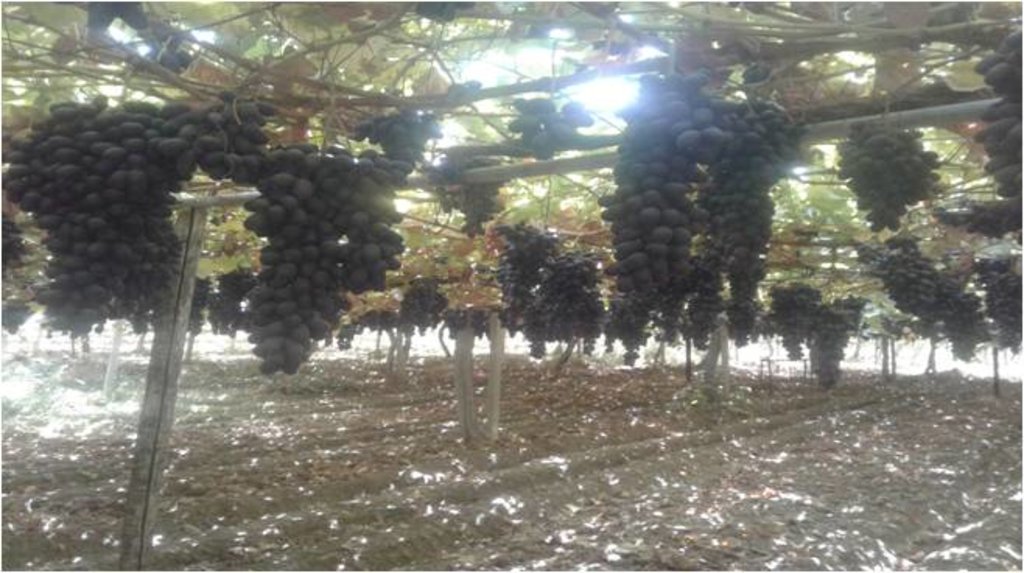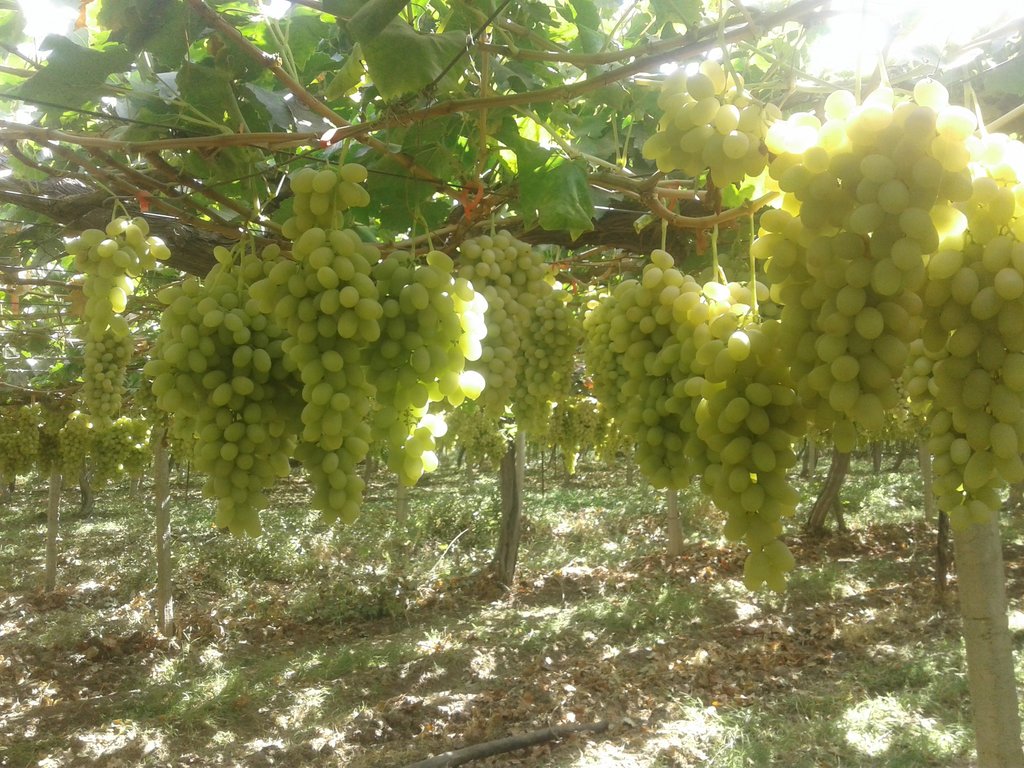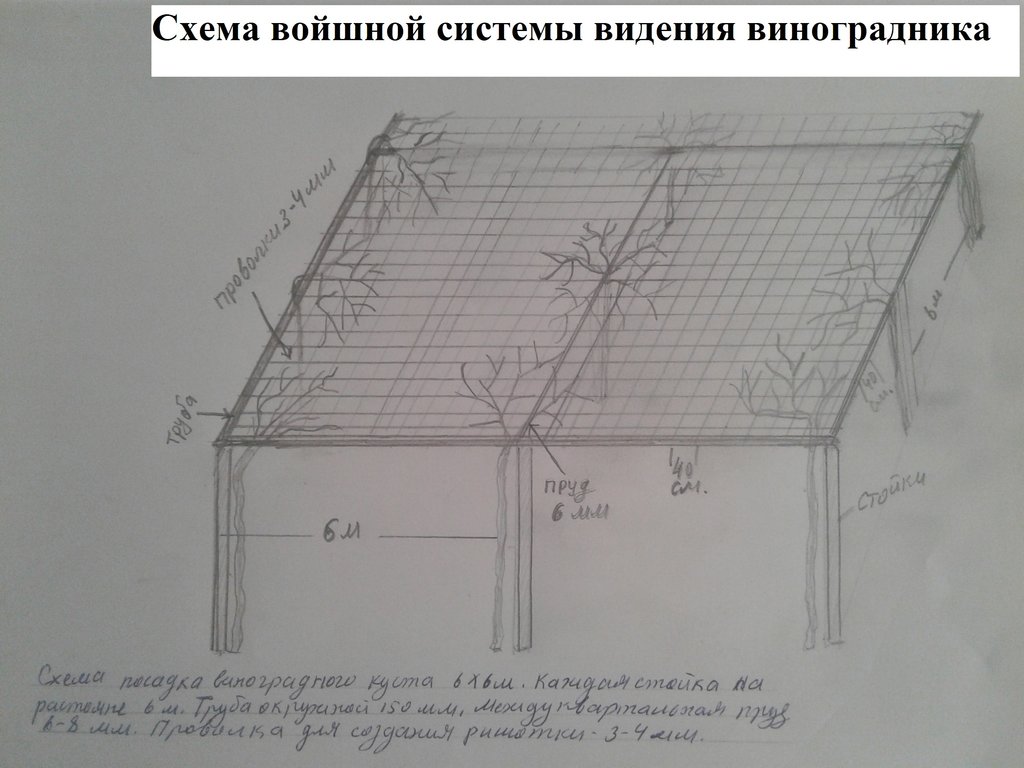: Сохранения почвенного покрова от эрозии и деградации путем возделывания воишным системе ведения виноградников [Tajikistan]
- Creation:
- Update:
- Compiler: Rustam Kalandarov
- Editor: –
- Reviewer: Farrukh Nazarmavloev
нигохдори замин аз таназул бовоситаи парвариши усули Токпарварии чойлоби………………………………………………………………………
technologies_3686 - Tajikistan
View sections
Expand all Collapse all1. General information
1.2 Contact details of resource persons and institutions involved in the assessment and documentation of the Technology
land user:
Усмонов Немат
919 14 25 55
Ватан 2008
Турсунзадевский район хохяйство "Ватан 2008"
Tajikistan
Name of project which facilitated the documentation/ evaluation of the Technology (if relevant)
Environmental Land Management and Rural Livelihoods (ELMAR)Name of the institution(s) which facilitated the documentation/ evaluation of the Technology (if relevant)
Youth Ecological Center, Tajikistan (Youth Ecological Center, Tajikistan) - Tajikistan1.3 Conditions regarding the use of data documented through WOCAT
When were the data compiled (in the field)?
12/03/2018
The compiler and key resource person(s) accept the conditions regarding the use of data documented through WOCAT:
Yes
1.4 Declaration on sustainability of the described Technology
Is the Technology described here problematic with regard to land degradation, so that it cannot be declared a sustainable land management technology?
No
Comments:
Технология является природосберегающем не вызывает эрозию и деградацию почвы.
2. Description of the SLM Technology
2.1 Short description of the Technology
Definition of the Technology:
В технологии приводится описание виноградников на воише: как кусты формировать, и устройство шпалеры, тип обрезки, схема посадки и Агро уход.
2.2 Detailed description of the Technology
Description:
Технология применялась в фермерском хозяйстве «Асадулло» на площади более 100 га. Природные условия богарные и поливные - под капельным орошением сады и виноградники. Землепользователи занимаются в основном садоводствам и виноградарством от которых получают хорошие доходы. Прежде чем начать эту технологию, необходимо предусмотреть следующие правила: провести подготовку почвы, необходимо подобрать участок, исходя из биологических особенностей сорта Выбранный участок должен соответствовать требованиям культуры и сорта. Уровень грунтовых вод не должен быть выше 1,5-2 м.
Культура видения воишной системы винограда нашла широкого хозяйственного применения в Центральном Таджикистане (Турсунзадевском, Шахринавском ,Гиссарском районе и хатлонском областе ).
При использование воишной системы ведения можно применят многих сортов особенно сильнорослых сорта виноград, как Хусайне, Тайфи розовый, Победа (Шахартуский черный)Кишмишный сорта, Зариф, Джавс которые стало популярным в нынешнем времени.
При формировке системы культуре воиш необходимо соблюдать некоторые общие правила и отличительные черты от других формировок: 1. каждые куст винограда должен занимать определенную площадь питания; 2. обрезку применяют длинную с образованием плодового звена; 3. Во избежание неравномерности роста отдельных частей куста, все части должен быть выведен на один определенные ярус; 4. в виду сравнительно меньшего числа плодоносных глазков у таких сортов, который мы причислили выше, регулирования величины нагрузки урожая гроздями переносить в основном на время обломки зеленных побегов; При выведении высокоствольных формировок важное роль играют правильное формирования здорового и мощного ствола (штамба) без поранений. К формирования ствола приступают в конце второго года вегетации, из развывшихся побегов выбирают наиболее мощный , имеющие длину вызревшей частей не менее двух метров. Выбранный побег, подрезают на высоту горизонтальной части воиша и подвязывают в строго вертикальном положении. При большой длине побега верхушку его плавно загибают и подвязывают к проволоке. Все глазки на вертикальной части штамба и на месте изгиба, за исключением 3-5 верхних , «ослепляют». Основная схема посадки 5 х 5; 6 х 5; и 6 х 6 м. Основная цель получит высокий урожай.
При воишном формирование виноградников повышается урожайность на 80-90% по сравнению без штамбовых формировок. С одного куста можно получит до 350 – 450 кг или урожая винограда. При возделывание виноградника расход обходится от 30 – 35 тыс. долларов США. Но эта после вступление урожая за 2-3 года окупается.
Единственный не удобность этой технологии в том, что затруднение вовремя агроухода как обрезка, зелёная операция и сбор урожая. Земле пользователям это тип формировки приемлема хотя она очень дорогая но все после вступления урожая окупается.
Воишная система ведения она является природосберигающем технологий покрывает почву тенью и сохраняет влажность почвы, опрыскивание против вредителей и болезни производится с низа на верх окрестность не повреждается от ядохимикатов сохраняет окружающую среду предотвращает эрозию и деградации почвы.
2.3 Photos of the Technology
2.5 Country/ region/ locations where the Technology has been applied and which are covered by this assessment
Country:
Tajikistan
Region/ State/ Province:
Турсунзадевский район
Further specification of location:
Кишлак Янгибог, хозяйства "2008"
Comments:
Технология принимается на западной части Таджикистана не долеко от центра района.
Map
×2.6 Date of implementation
Indicate year of implementation:
1998
If precise year is not known, indicate approximate date:
- 10-50 years ago
2.7 Introduction of the Technology
Specify how the Technology was introduced:
- as part of a traditional system (> 50 years)
- during experiments/ research
Comments (type of project, etc.):
Технология считается как традиционная система землепользования с давных времен. также научно обоснованно.
3. Classification of the SLM Technology
3.1 Main purpose(s) of the Technology
- improve production
- reduce, prevent, restore land degradation
- adapt to climate change/ extremes and its impacts
- create beneficial economic impact
3.2 Current land use type(s) where the Technology is applied

Cropland
- Tree and shrub cropping
Main crops (cash and food crops):
Основной сельскохозяйственная культура это плодоносящие виноградники.
Comments:
Основной культура выращивания это традиционная воишная система ведения виноградников.
If land use has changed due to the implementation of the Technology, indicate land use before implementation of the Technology:
До применения технологии было овощные культуры.
3.3 Further information about land use
Water supply for the land on which the Technology is applied:
- full irrigation
Comments:
Технология принимается только на поливных зонах.
Number of growing seasons per year:
- 1
Specify:
Урожай получает один раз за сезон вегетации.
3.4 SLM group to which the Technology belongs
- improved ground/ vegetation cover
- integrated soil fertility management
- cross-slope measure
3.5 Spread of the Technology
Specify the spread of the Technology:
- evenly spread over an area
If the Technology is evenly spread over an area, indicate approximate area covered:
- 1,000-10,000 km2
Comments:
Площадь под этой технологии в настоящем времени более 500 га только на одном хозяйстве.
3.6 SLM measures comprising the Technology

agronomic measures
- A1: Vegetation/ soil cover

vegetative measures
- V1: Tree and shrub cover
Comments:
Технология используется агрономические и растительно многолетних культур.
3.7 Main types of land degradation addressed by the Technology

soil erosion by water
- Wt: loss of topsoil/ surface erosion

soil erosion by wind
- Et: loss of topsoil
Comments:
Основная направления технологии это предотвращения эрозии воды и почвы. Также ветрозащитная от утрата плодородия почвы.
3.8 Prevention, reduction, or restoration of land degradation
Specify the goal of the Technology with regard to land degradation:
- prevent land degradation
- reduce land degradation
Comments:
Технология предотвращает деградацию и эрозию почвы.
4. Technical specifications, implementation activities, inputs, and costs
4.1 Technical drawing of the Technology
4.2 Technical specifications/ explanations of technical drawing
На схеме приведено данные по устройству воиша. Схема посадка. стойки, натяжные проволок, саженцы (кусты винограда ) размеры проволок.
4.3 General information regarding the calculation of inputs and costs
Specify how costs and inputs were calculated:
- per Technology area
Indicate size and area unit:
на 1 га.
If using a local area unit, indicate conversion factor to one hectare:
10000 метр квадрат
Specify currency used for cost calculations:
- US Dollars
Indicate exchange rate from USD to local currency (if relevant): 1 USD =:
8.9
Indicate average wage cost of hired labour per day:
3.0
4.4 Establishment activities
| Activity | Type of measure | Timing | |
|---|---|---|---|
| 1. | Подготовка земли | Agronomic | осенью |
| 2. | Разбивка участок | Agronomic | Весна |
| 3. | Посадка саженца | Agronomic | Весна |
| 4. | Ставка стойки (шпалера) и упоры. | Agronomic | течения вегетации |
| 5. | натяжка проволок двух сторонно | Agronomic | течения вегетации посли посадки винограда. |
| 6. | агроуход | Agronomic | течения вегетации |
Comments:
Мероприятия проводится по сезонам необходимости. После посадки желательно надо ставит стойки и обязательно натяжка проволок. проволоки натягивают 3 мм. и 8 мм.
4.5 Costs and inputs needed for establishment
| Specify input | Unit | Quantity | Costs per Unit | Total costs per input | % of costs borne by land users | |
|---|---|---|---|---|---|---|
| Labour | Ручная работа | день | 12.0 | 5.5 | 66.0 | 100.0 |
| Labour | Механизированная работа | день | 15.0 | 18.3 | 274.5 | 100.0 |
| Plant material | Саженцы винограда | шт | 277.0 | 0.5 | 138.5 | 100.0 |
| Construction material | труба 100 мм. | м | 132.0 | 8.5 | 1122.0 | 100.0 |
| Construction material | Проволоки 4 мм | кг | 1300.0 | 0.54 | 702.0 | 100.0 |
| Construction material | проволоки 8 мм | м | 594.0 | 2.0 | 1188.0 | 100.0 |
| Construction material | Шпалер | шт | 277.0 | 2.4 | 664.8 | 100.0 |
| Other | итого | 46908.0 | 1125.8 | |||
| Total costs for establishment of the Technology | 4155.8 | |||||
Comments:
частная хозяйства каждый земле пользователь сами покрывают затраты.
4.6 Maintenance/ recurrent activities
| Activity | Type of measure | Timing/ frequency | |
|---|---|---|---|
| 1. | Агроуход | Agronomic | Постоянно |
Comments:
Мероприятия проводится по сезонам необходимости. После посадки желательно надо ставит стойки, упоры и обязательно натяжка проволок. проволоки натягивают 3 мм. и 8 мм.
4.7 Costs and inputs needed for maintenance/ recurrent activities (per year)
| Specify input | Unit | Quantity | Costs per Unit | Total costs per input | % of costs borne by land users | |
|---|---|---|---|---|---|---|
| Labour | Ручная работа | день | 10.0 | 5.5 | 55.0 | 100.0 |
| Labour | Миханизированная работа | день | 5.0 | 18.3 | 91.5 | 100.0 |
| Total costs for maintenance of the Technology | 146.5 | |||||
Comments:
Частная хозяйство каждый землепользователь все затраты покрывается землепользователям
4.8 Most important factors affecting the costs
Describe the most determinate factors affecting the costs:
Наиболее значимые это труба, стойки Шпалер,
5. Natural and human environment
5.1 Climate
Annual rainfall
- < 250 mm
- 251-500 mm
- 501-750 mm
- 751-1,000 mm
- 1,001-1,500 mm
- 1,501-2,000 mm
- 2,001-3,000 mm
- 3,001-4,000 mm
- > 4,000 mm
Specifications/ comments on rainfall:
Осадки выпадают в основном весной осенью и зимой в долинных зонах осадки выпадают не более 350 400 мм.
Indicate the name of the reference meteorological station considered:
ГМС г. Душанбе
Agro-climatic zone
- sub-humid
5.2 Topography
Slopes on average:
- flat (0-2%)
- gentle (3-5%)
- moderate (6-10%)
- rolling (11-15%)
- hilly (16-30%)
- steep (31-60%)
- very steep (>60%)
Landforms:
- plateau/plains
- ridges
- mountain slopes
- hill slopes
- footslopes
- valley floors
Altitudinal zone:
- 0-100 m a.s.l.
- 101-500 m a.s.l.
- 501-1,000 m a.s.l.
- 1,001-1,500 m a.s.l.
- 1,501-2,000 m a.s.l.
- 2,001-2,500 m a.s.l.
- 2,501-3,000 m a.s.l.
- 3,001-4,000 m a.s.l.
- > 4,000 m a.s.l.
Indicate if the Technology is specifically applied in:
- not relevant
Comments and further specifications on topography:
Технологию можно использовать предгорных равнинах склонах но только должно быт полив.
5.3 Soils
Soil depth on average:
- very shallow (0-20 cm)
- shallow (21-50 cm)
- moderately deep (51-80 cm)
- deep (81-120 cm)
- very deep (> 120 cm)
Soil texture (topsoil):
- medium (loamy, silty)
Soil texture (> 20 cm below surface):
- medium (loamy, silty)
Topsoil organic matter:
- medium (1-3%)
If available, attach full soil description or specify the available information, e.g. soil type, soil PH/ acidity, Cation Exchange Capacity, nitrogen, salinity etc.
Нет данных
5.4 Water availability and quality
Ground water table:
> 50 m
Availability of surface water:
good
Water quality (untreated):
good drinking water
Is water salinity a problem?
No
Is flooding of the area occurring?
No
Comments and further specifications on water quality and quantity:
Вода для пития и полива достаточно. Самотек аричная . Питьевая водопроводная.
5.5 Biodiversity
Species diversity:
- medium
Habitat diversity:
- medium
Comments and further specifications on biodiversity:
Видовая разнообразия деревья кустарники и местообитание пространственно средняя
5.6 Characteristics of land users applying the Technology
Sedentary or nomadic:
- Sedentary
Market orientation of production system:
- subsistence (self-supply)
Off-farm income:
- 10-50% of all income
Relative level of wealth:
- rich
Individuals or groups:
- individual/ household
Level of mechanization:
- manual work
- animal traction
Gender:
- women
- men
Age of land users:
- youth
- middle-aged
Indicate other relevant characteristics of the land users:
Землепользователи часто пользуют наёмными рабочими, но основной семейный или бригадный.
5.7 Average area of land owned or leased by land users applying the Technology
- < 0.5 ha
- 0.5-1 ha
- 1-2 ha
- 2-5 ha
- 5-15 ha
- 15-50 ha
- 50-100 ha
- 100-500 ha
- 500-1,000 ha
- 1,000-10,000 ha
- > 10,000 ha
Is this considered small-, medium- or large-scale (referring to local context)?
- large-scale
Comments:
Хозяйство считается крупными более 100 га каждому землепользователю.
5.8 Land ownership, land use rights, and water use rights
Land ownership:
- company
Land use rights:
- open access (unorganized)
- communal (organized)
Water use rights:
- open access (unorganized)
- communal (organized)
Comments:
Частная компания пользование земель неограничено но контролируются
5.9 Access to services and infrastructure
health:
- poor
- moderate
- good
education:
- poor
- moderate
- good
technical assistance:
- poor
- moderate
- good
employment (e.g. off-farm):
- poor
- moderate
- good
markets:
- poor
- moderate
- good
energy:
- poor
- moderate
- good
roads and transport:
- poor
- moderate
- good
drinking water and sanitation:
- poor
- moderate
- good
financial services:
- poor
- moderate
- good
6. Impacts and concluding statements
6.1 On-site impacts the Technology has shown
Socio-economic impacts
Production
crop production
Comments/ specify:
После применение технологии намного улучшилось
crop quality
Comments/ specify:
После применение технологии намного увеличилось урожай.
6.2 Off-site impacts the Technology has shown
Comments regarding impact assessment:
Технология к этим прилагаемым территории никаких влияние не имеет.
6.3 Exposure and sensitivity of the Technology to gradual climate change and climate-related extremes/ disasters (as perceived by land users)
Gradual climate change
Gradual climate change
| Season | Type of climatic change/ extreme | How does the Technology cope with it? | |
|---|---|---|---|
| annual temperature | increase | well | |
| seasonal temperature | dry season | increase | well |
| annual rainfall | decrease | well | |
| seasonal rainfall | winter | decrease | well |
Climate-related extremes (disasters)
Meteorological disasters
| How does the Technology cope with it? | |
|---|---|
| local hailstorm | well |
Climatological disasters
| How does the Technology cope with it? | |
|---|---|
| heatwave | moderately |
| cold wave | moderately |
| drought | moderately |
Other climate-related consequences
Other climate-related consequences
| How does the Technology cope with it? | |
|---|---|
| reduced growing period | moderately |
Comments:
Технология так оно воишная всякие погодные явления кроме холодного зимы не очень влияет на рост и развитию винограда
6.4 Cost-benefit analysis
How do the benefits compare with the establishment costs (from land users’ perspective)?
Short-term returns:
positive
Long-term returns:
positive
How do the benefits compare with the maintenance/ recurrent costs (from land users' perspective)?
Short-term returns:
positive
Long-term returns:
positive
Comments:
Все получаемые результаты с текущими расходами позитивна.
6.5 Adoption of the Technology
- 10-50%
If available, quantify (no. of households and/ or area covered):
число домохозяйств более 10 плошадь не менее 50 га.
Of all those who have adopted the Technology, how many have did so spontaneously, i.e. without receiving any material incentives/ payments?
- 10-50%
6.6 Adaptation
Has the Technology been modified recently to adapt to changing conditions?
No
6.7 Strengths/ advantages/ opportunities of the Technology
| Strengths/ advantages/ opportunities in the land user’s view |
|---|
| воздухопроницаемость, экономной использование воды. |
| почвосберегающая |
| Качество урожая увеличилось на 3-4 раза больше. Большая экономическая эффективность |
| Strengths/ advantages/ opportunities in the compiler’s or other key resource person’s view |
|---|
| воздухопроницаемость, почвосберегающая. |
| Вода пользуется по мерам. |
6.8 Weaknesses/ disadvantages/ risks of the Technology and ways of overcoming them
| Weaknesses/ disadvantages/ risks in the land user’s view | How can they be overcome? |
|---|---|
|
Затруднения дороговизна технология для начало Обрезка, |
|
| Некоторые агроуходы |
| Weaknesses/ disadvantages/ risks in the compiler’s or other key resource person’s view | How can they be overcome? |
|---|---|
| Затруднения дороговизна технология для начало |
7. References and links
7.1 Methods/ sources of information
- field visits, field surveys
- interviews with land users
5 - землепользователи
7.2 References to available publications
Title, author, year, ISBN:
Виноградарство таджикистана Кирилов ., А.Д.Савченко., М.И. Броддниковский.. Подколзин И.В.
Available from where? Costs?
г. Душанбе .0,3
Title, author, year, ISBN:
Пути и повышения урожайности садов, виноградников и овощных култур. Опыт внедрения системы возделования винограда на воише в условиях Южного Таджикистана.. АБдурахманов Н.А. Каландаров Р.Ю., Раджабов А.Ш., Мвхмуди М.
Available from where? Costs?
г.Душанбе 2112г. 3,0 доллар.
Links and modules
Expand all Collapse allLinks
No links
Modules
No modules






